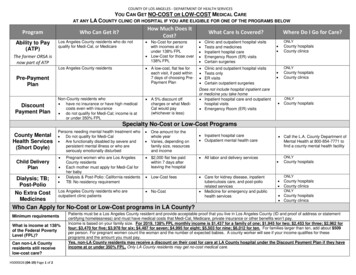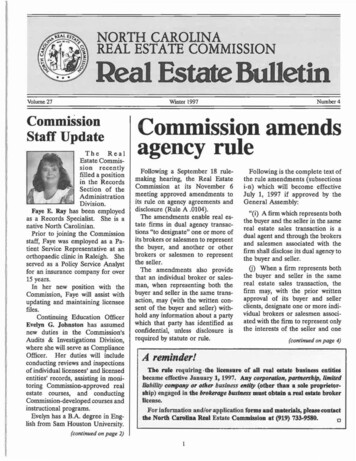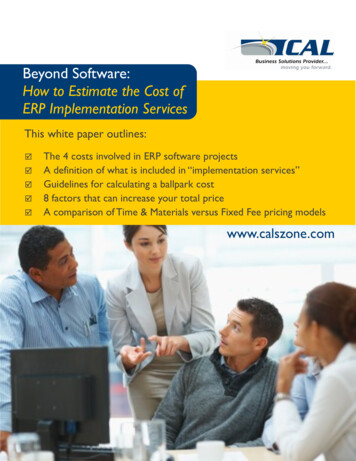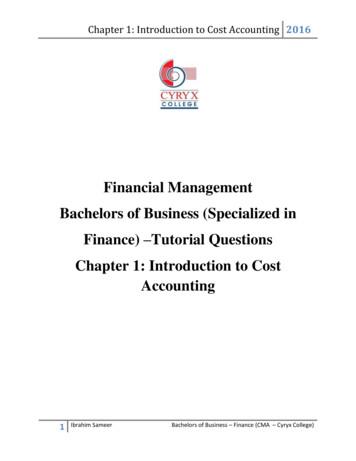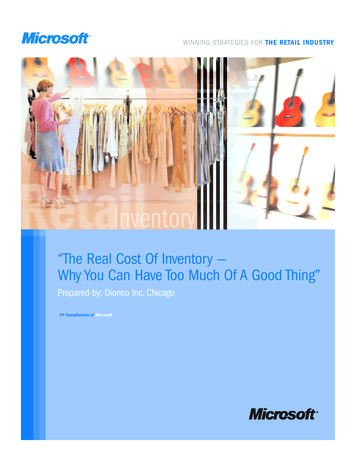
Transcription
WINNING STRATEGIES FOR THE RETAIL INDUSTRY“The Real Cost Of Inventory —Why You Can Have Too Much Of A Good Thing”Prepared by: Dionco Inc. Chicago Compliments of MicrosoftThe Real Cost Of Inventory Microsoft
“TheReal Cost of Inventory —Why You Can Have Too Much Of A Good Thing”It is a fact that for almost all retailers inventory is the single largest asset on the balance sheet. Yet, despite all the improvements in technologyover the past twenty five years, inventory continues to be the least productive asset for most retailers.To determine inventory productivity we use a measure called “turnover” which tells us how many times does inventory sell out in a year. Inalmost every segment of specialty retail - gift, clothing, sporting goods, jewelry, shoes, books, music, electronics, appliances, furniture, and manymore – the stock turnover rates have held steady for over 25 years in the under 4 range and in a few cases, at less than 2 turns per year.This means that for most of these stores they are carrying at least three months of sales in their store at any given moment, and in the case ofbooks and some other categories, the inventory approaches a six month supply at most times. This amount of inventory is not only a drain onthe stores’ financial position, but it also often reduces customer service because in most cases the store cannot afford to re-stock what isselling because they have too much of what is not selling.Clearly, retailers need to take a step back and critically address this problem and begin to manage this asset in a more planned anddisciplined way.There are three factors that have the biggest impact on inventory. First the SKU intensity of the product, second the re-order cycle time andlastly the nature of the merchandise, either consumables or discretionary. These three factors each bring a special twist to the inventoryproblem and we will discuss each one while giving you some insights into how to address them in order to maximize your inventory investment.We will also discuss some secondary factors such as seasonality, fashion and obsolesce as well as a critical measure of inventory productivitycalled Gross Margin Return On Inventory Investment (GMROII).The Real Cost Of Inventory Microsoft1
SKUIntensityThe first and often the most critical factor in inventory management is what is termed “SKU Intensity”. This is simply how many stock keepingunits (SKU’s) you have per item. If you sell items such as gifts, you will often have just one SKU per item. Each item comes as a unique orsingle size piece and if you expect to sell, let’s say, twelve of those items in a month, you only need to have twelve on hand to make those sales(if your order cycle is short, you may even have less on hand at any given moment, as we will discuss that later).Contrast this with a clothing store, in which you may have an item which comes in four sizes (S, M, L, XL) and three colors (red, blue, green).How many items do you have to have in inventory to guarantee that you will sell twelve that month? The answer is the astounding number ofone hundred forty four. As you would have to assume that it was possible that every customer that month would want the same size and samecolor, you would have to stock twelve of each size and color.Now, in the real world we would not plan for a one hundred percent customer service level1 and you would likely “tailor” your inventory, whichmeans that, based on past history, you would/should know that ten percent of your customers are size small, thirty percent medium, fortypercent large and twenty percent extra large. You would also know that your best selling color is blue, often over eighty percent, followed by redat twenty percent and that you never sell very many green of any type of this item. Based on this knowledge (which you must have from yourPOS and inventory system history), you can purchase and stock far less than the one hundred and forty four that was possible and you couldeasily attain a ninety five percent customer service level with as few as twenty items or less.That is the power of tailoring a SKU intensive inventory, but it does require good sales history as well as good inventory history and anunderstanding that there are other factors that may be involved. So, for instance, imagine if your reports told you that you never sold anysize small, what if you never had any size small to sell? Your POS system reports will tell you what sold but you also have to look at yourinventory reports to know that you had stock on that size or color and the reason why you did not have a sale was because the customerdid not buy, not because it was not there to purchase.The more SKU intensive your inventory the more you have to depend on sales and inventory information when you purchase new items.The skill of tailoring an inventory is learned and each season you will get better at it.There is another danger beyond out of stocks misrepresenting your true sales pattern. An item may not “trend” or “fit” or be “identical” tothe past item. What if the new item that you are buying does not fit the same way? What if it is sized slightly smaller than other items inthe past? If this happens your size balance will be all off as customers try the items and purchase a size larger than they did in the past,causing you to end up with no sales in small and not enough stock in extra large. Or, what if the traditional blue is not as good looking asthe red in a particular item, or if customers’ tastes change and more want green this season? These factors change the mathematicalcomputation of required inventory to a more complex decision that requires that the buyer take into account not only the raw numbersbut also the additional factors that can change the purchase mix.You have to have both the hard sales and inventory numbers as well as knowledge of your merchandise and customers. It is a constantprocess that is never perfect but can be close to perfection if you work at it.1Customer service level measures how many times you tell a customer that you are out of stock as a percentage to total demand. So a 100% customer service level means that you are never outof stock on an item.The Real Cost Of Inventory Microsoft2
Re-Order Cycle TimeThe second factor that impacts inventory is what is termed “re-order cycle time” or simply how long it takes you to be re-supplied onceyou have either run out or determined that you have need for more. The longer the cycle time the greater the amount of inventory that youhave to carry. The re-order cycle begins at the moment you determine that you need more inventory.An inventory efficient retailer will have computer systems that identify when an item should be replenished. This is done by establishingwhat is called a “model stock”, or a desired inventory level. Once this is established (by SKU), then the computer will keep an eye on thatitem and when sales reduce the amount on hand to the level that it needs to be replenished, the computer will either generate a“suggested order” report or automatically re-order that item. The two most important factors in establishing the model stock level are rateof sale and ship time.For example, if you have an item that you know can be replenished by a supplier that is in your city and he/she always has the item onhand and can deliver in less than three days from the time the supplier receives the order, and you also know that it takes you two days toreceive the merchandise and get it to the shelf, then if you are looking at your suggested re-order every day, you have a five day order cycle.However, if you look at your suggested re-order once a week, then your order cycle time is twelve days, (seven days for identifying need plusfive days to get the merchandise). If you sell ten of that item per week, and you are running your suggested re-order report once a week,then you have to have a minimum of 18 on hand.2 You may also want to “protect” yourself if this is an important item, by having what wecall “safety stock”. Safety stock is additional inventory that you will carry just in case something goes wrong. Maybe, the supplier will have aproblem in shipping or picking up the item and it will be delayed by one or two days. Maybe, you will be on vacation and run the suggestedreplenishment report late. Maybe, a customer will buy more than expected or the item gets more popular for a short time.Any or all of these factors may cause you to build-in a safety stock number that will ensure that you do not run out of stock and arecovered for a period of twelve days to fifteen or even twenty. However, you should be very careful about increasing the stock coveragenumber as it not only increases your inventory levels but it decreases your stock turnover at the same time. In the above example, if youdid not have a safety stock your stock turnover in units would be 28.8 (520 unit sales with an average unit inventory of 18). If youincreased your safety stock to twenty days your unit turnover would drop to 17.9 (520 unit sales with an average inventory of 29 units)while your stock turnover would be reduced by 38%.3 Any decision to build in a safety stock should only be made after carefulconsideration and an understanding of the impact on store performance. Natureof the MerchandiseThe third factor that will affect inventory productivity is the nature of the merchandise. Some products are purchased every day/week bycustomers and some are purchased much more infrequently. For example, a customer may buy five or six picture frames a year, or six orseven shirts or blouses a year, or nine or ten tubes of toothpaste per year. Conversely, they will likely buy only one television set everyten or fifteen years (although this may be reduced to an average of three to five years if they purchase additional TV sets for otherrooms in the house).Products that have a high purchase frequency almost always have a lower replacement price. Imagine if toothpaste costs as much as aTV set, purchase frequency and dental hygiene would both suffer! On the other hand, merchandise with a low purchase frequency hasoften a higher price. This is also termed “deliberation” merchandise because the customer often has to take time to consider thepurchase and more than one trip to the store is often required. This is very common in furniture, floor covering, jewelry, electronics,appliances and many home improvement categories.Deliberation merchandise will often stay on the selling floor longer than impulse or consumables and your stock turnover will reflect thisdifference. Even in consumables there may be certain sizes or types of merchandise that is more specialized and takes longer to sell.2Formula is sales per day times the days required. In this example, ten per week is 1.4285 per day times twelve days equals 17.14 units rounded up to the next full unit, which is 18.Original stock turns of 28.8 minus new stock turn of 17.9 equals a loss of 10.9 turns divided by the original of 28.8 equals a decrease of 37.84%3The Real Cost Of Inventory Microsoft3
You may have to carry a complete range of a product even though certain items are very slow sellers. For example, you may haveaccessories in an electronics store that have a good rate of turnover but specific couplers or adapters may only be needed by a veryfew customers yet you have to have them for those customers. You would therefore have some items in your accessories that onlyturned two times per year while the more common accessories turned over twelve times per year.The key in ensuring profitability in the case of deliberation merchandise and slow moving items, is to make sure that they carry a highermargin than the faster moving items. They have to, in essence, “pay the rent” for all the time that they are just sitting on the shelf. This isalso true in fashion merchandise where there is a degree of risk involved. Fashion merchandise may also include items that have very highpossibility of obsolescence, such as, some consumer electronics that may be replaced by a newer model with more features or a lowerprice. Fashion merchandise has to carry a higher initial gross profit to accommodate the markdowns that will surely occur over the life ofthe item. Which leads us to the great equalizer in the inventory analysis and that is Gross Margin Return On Inventory Investment (GMROII). GMROIIGMROII is a financial measure that tells us what return we are making on our inventory investment. It is the only financial ratio formulathat returns a dollar answer not a percentage. The question that GMROII answers is “For every dollar that I invest in inventory, what is myreturn?” GMROII is the measure that helps you to balance the turnover of an item and its retail price. If you have an item that turns onlytwice a year you have to make a much higher profit on that item as you are only making the profit two times and yet paying to keep theitem the entire year. Contrast this with an item that you will sell three of per week or 156 per year and only need to pay to keep six onhand. Your investment in the slow turning item is longer and therefore more costly.The formula for GMROII is simply Gross Margin (the profit – or return on investment you make in selling an item – after anydiscounts/markdowns are taken) divided by the average inventory at cost (the “investment” that you have made).Let’s look at two very different items and the GMROII on each.Item A Fast selling, low price item. You sell 156 of this item per year. You buy it for 5.00 each and sell it for 7.00 each. You keep sixin inventory all the time so your investment at cost is 30 ( 5.00 times 6 items). In one year, if you sell the 156 at full price of 7.00 you make a profit of 2.00 per item for a total profit of 312.00. To make the 312 profit, you only had to invest 30in inventory cost. So, your GMROII is 10.40 ( 312 divided by 30), which means that for every dollar that you invested ininventory you made a 10.40 return.Item B Slow selling, high price item. You sell two of these items per year. You buy it for 325.00 and sell it for 999.00. You keeptwo in inventory so your investment is 650 ( 325 times 2 items). In one year you sell two items for total sales of 1,998.00 and make 674 per item or 1,348 for the two. To make 1,348 sales you had to invest 650 in inventory. So,your GMROII is 2.07 ( 1,348 divided by 650) which means that for every dollar that you invested in inventory you madea 2.07 return.The two examples above clearly show the difference that a GMROII analysis can make. The first item has a Gross Margin of 28.6%4 ,while the second item has a Gross Margin of 67.5% . If we were just to consider Gross Margin, we would identify item B with the 67.5%margin as being very good and item A with a 28.6% margin as being not so profitable. Whereas, the GMROII analysis demonstrates theproductivity of item A over item B.However, we also have to remember that we don’t pay the bills with percentages. Item A only put 312 in my checking account whileItem B put 1,348. Clearly, a balance must be achieved between dollars and GMROII rates. A 2.07 GMROII may represent substantialdollars in the above example, but for most stores, this is actually a break even. The first dollar of the 2.07 is simply the dollar that weinitially invested and the second 1.07 has to be used to pay all operating expenses such as rent, payroll, supplies, advertising etc. Soa GMROII of 2.00 is considered just a break even and we really should be setting a benchmark of at least 3.00 for eachcategory/item in our stores.4Gross Margin percent is calculated by dividing selling price minus cost to selling price. So, 7.00 minus 5.00 equals 2.00 divided by 7.00 which equals 28.6%. This means that our profit is28.6% of our selling price.The Real Cost Of Inventory Microsoft4
Getting Our Inventory in BalanceThe best way to balance an inventory is not to overbuy in the first place, but that is easier said than done! The main way that retailerskeep inventories in line is through the use of markdowns, or reductions in inventory selling price to incent customers to buy at the lowerprice. The main purpose of markdowns is either to promote an item for a limited time to get traffic and sales in the store (calledpromotional markdowns) or to properly value our inventory (called regular markdowns). The latter, to properly value our inventory, is whatyou should always strive for.A good retailer examines their inventory on at least a monthly basis, some even do it weekly. An inventory evaluation begins with anexamination of the age of the current inventory. Generally speaking, any inventory that is less than four months old is considered currentinventory, although high turn retailers will lower this number to as little as eight weeks old. Any inventory from four months to eightmonths old is considered slow moving and may require a small markdown to increase the rate of sale. Any inventory over eight monthsold is considered old inventory and therefore subject to a deeper markdown to clear it. A good store will never have any “birthday”inventory, which is merchandise that has been around for over one year.Generally speaking, the amount of discount or markdown required on any item is based on three factors: the current on hand, thecurrent rate of sale and the desired stock turn. For example, if you have an item that has an on hand of 200 units, a rate of sale of tenper week, you know that you have twenty weeks supply of that item. If you are trying to turn it four times, you are not going to make it atthe current rate of sale. Four stock turns would mean that an item is in inventory for no more than thirteen weeks, and this item may behere for twenty, so you have seven more weeks of supply than you need. You might take a small markdown (10 to 20%) to speed up therate of sale on this item so that it sells fifteen per week and brings you to almost out within the thirteen weeks. Contrast this with anitem that you also have 200 of, but the rate of sale is two per week. At that rate of sale, you have almost two years supply. Clearly, youhave to take a substantial markdown to get the rate of sale up to fifteen per week. This item could easily require a markdown in the70% off range.A markdown should be viewed as ‘tuition that we pay for an education about our customer’. A good rule is to never take a markdownunless you know why you are doing it. Your Next StepsHere are five suggestions that will help keep you out of inventory trouble:1. Control your inventories (never buy more than you can realistically expect to sell in eight weeks). Ask yourself with every PO that youwrite, “Do I really need this much?” Remember that scarcity increases demand and that it is easy to buy 500 of any items, but muchmore difficult to find 500 customers that want it.2. Always try to get exclusives so you are not being shopped on an apples to apples comparison basis. If you cannot get totalexclusivity, then get time (first three months) or get geographic (only one in your city to sell it), or channel, (only gift store). Even ifyou can get different packaging that will make it look less like the others, it can work.3. Nurture your customers who do not shop you on price alone. Send thank you cards and maintain close relationships with those goodcustomers. Help them by creating gift registries, remembering important dates for them, become more than an item provider in theirlife. Add value to what you do for them.4. Always keep your markdown items at the back of the store where the customer has to search to find them. Drag them through thetotal store and tempt them with your good items before they see the markdowns.The Real Cost Of Inventory Microsoft5
5. Remember, the price you paid for the item has nothing to do with the selling price. We have always said that “Your first markdown isthe cheapest”. If you t
computation of required inventory to a more complex decision that requires that the buyer take into account not only the raw numbers but also the additional factors that can change the purchase mix. You have to have both the hard sales and inventory numbers as well as knowledge of your


